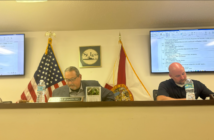On Oct. 21, Robert Edsel addressed the Saint Leo community and guests regarding a group of unsung WWII heroes. Edsel is the man responsible for bringing this group, known as Monuments Men, into the modern day limelight thanks to his research into their work and the books he has written about them. Edsel founded the Monuments Men Foundation in 2007 to carry on the legacy of the group.
“What drives me is meaningfulness,” Edsel said. “I got hugely interested in art and architecture. I always say: Florence is my classroom and Europe is my school.”
Curiosity led Edsel away from owning his own business to picking up and moving to Florence, Italy, to study European art. The arts brought him to the doorstep of his research in the “monuments men,” soldiers during World War II dedicated to preserving the European artwork in the war zone. They would attempt to steer the bombing away from museums and fix damaged artworks after the war shifted from mostly air strikes to fighting on foot.
According to the Monuments Men foundation, their namesake was a military group founded in 1943, when President Roosevelt approved the forming of the “American Commission for the Protection and Salvage of Artistic and Historic Monuments in War Areas.” The move was necessary on Roosevelt’s part when it came to his attention the extensive threat Adolf Hitler and the Nazi regime posed to the cultural and artistic treasures in war-torn Europe.
An aspiring artist in his youth, Hitler’s rejection from art school did not deter him from being a lover of art. As his power and influence in Germany grew, he began to lay plans to establish a new museum in the village of Braunau Am Inn, where he was born. It was to be the cultural center of Hitler’s empire, and he aspired to fill it with the most awe-inspiring masterpieces known to man.
Nothing was safe from Nazi looting. Paintings, books from famous libraries, stained glass stripped from cathedrals, church bells, ancient torrahs from synagogues- anything of value that the Nazis came across was seized. In 1939 museums across Europe closed their doors and scrambled to evacuate their valuables to protect them from looting and bombing during the war. For pieces too large to be moved, protective measures were taken to protect them from potential damage from bombs. Thousands of items ranging from priceless works of art to the silverware and valuables of victims were stolen as the Nazis’ influence spread through Europe.
Nazis would steal and hide important artworks for Hitler’s museum until the “monument men” discovered the cave in which many of the 5 million objects that were taken were kept. In total, there were 354 monument men working towards a common cause – to save art, and in doing so, preserve European culture.
Dr. Mary Spoto, the Dean of the College of Arts and Sciences and a member of the University Speakers Series’ committee, emphasized the necessity for the preservation of artwork.
“Art is a reflection of who we are – an extension of our own humanity. For a culture to be vibrant and well, its art must survive,” said Spoto.
The job of the Monuments Men was originally limited to the preservation of artifacts and cultural treasures, a job easier said than done while the fighting was still going on in Europe. With concern first and foremost being preoccupied with winning the war, most of the resources were put into supporting ground troops. Several sacrificed their lives in their pursuit to hunt down looted cultural treasures amongst the violence and fighting.
It was not until the last year of the war that the Monuments Men were really able to get down to doing what they had left their homes behind for. With the fighting winding down, they were able to track and locate stolen items and eventually begin returning them to their rightful owners. When the war ended in 1945 and the combat troops began to return home, the work of the Monuments Men was only beginning.
For six years, the group stayed hard at work in Europe, tracking down hidden storehouse of Nazi loot, often stumbling among stockpiles with astronomical values. With each discovery, items were carefully identified and sent back to their homes. In 1951, with well over a thousand items still missing, the Monuments Men returned to America. Already, new conflict had risen, and so their work was not openly discussed. Many of the men and women who had done so much in Europe to protect the cultural heritage there carried on similar work at home, working in various cultural and educational institutions all over the nation.
Today, the Monuments Men Foundations reports that there are six living Monuments Men—Harry Ettlinger, Richard Barancik, Horace Apgar, Bernard Taper, Anne Oliver Popham Bell and Lennox Tierney. The Foundation also says that their work is still not finished, with hundreds of thousands of missing cultural documents and artifacts still unaccounted for.
Edsel’s presentation resonated deeply with some students who attended, especially his question about just how far people are willing to preserve art.
“Me personally, I would risk my life for art because art ties us to our culture and history, and that’s something worth dying for,” said Anthony Russian.




